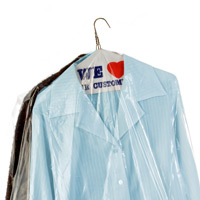
Of the 30,000 garment cleaning facilities in the US, more than 5,000 are in California. These mostly small, independently owned businesses are located near residential communities. Traditional dry cleaning solvents like perchloroethylene (perc) are known to be carcinogens, reproductive toxicants, and damaging to the liver, kidneys and the nervous system.
More than 75% of dry cleaning sites in the US are contaminated with hazardous substances. This affects the water and land around those sites and thus the natural habitat.
Legislation passed by the California Air Resources Board requires all dry cleaners in California to stop operating their perc machines by 2023. Perc dry cleaners in co-residential buildings and those using machines greater than 15 years old had to retire their machines by July 1, 2010 and switch to an alternative machine.
Garment Cleaning Solvents
Perc is a known carcinogen on the California Proposition 65 list. It causes liver and kidney damage, and is an irritant and a neurotoxicant. It is also persistent in the environment. Occupational exposure to perc can lead to neurological effects, reduced fertility and spontaneous abortions. High levels of exposure in enclosed spaces, even for short periods of time, can cause respiratory failure and even death.
Common substitutes— like hydrocarbon solvents that are a blend of Stoddard’s Solvent— contain carcinogens such as benzene and can bioaccumulate in humans and animals. Hydrocarbon solvents like EcoSolv and Shell Sol contain chemicals of concern that can be neurotoxicants, irritants and potential aquatic toxicants.
A proposed alternative, GreenEarth® contains a chemical that is a suspected carcinogen, reproductive toxicant and affects the liver, immune and nervous systems. It is also persistent in the environment and highly combustible.
Professional wet cleaning has been identified as an environmentally friendly, non-smog forming technology that is the safer choice.
Download San Francisco Department of the Environment's factsheet Dry Cleaning: How to Green Your Cleaning (PDF).
Benefits of Wet Cleaning
Most items labeled “dry clean only” can be professionally wet cleaned without shrinkage or damage.
Garment cleaning businesses that move to wet cleaning practices can have the following benefits:
- Lower operating and equipment costs
- Cleaning quality comparable to using perc and hydrocarbon
- Eligibility to become a San Francisco-certified Green Business
- Larger consumer base as demand for green cleaning technology grows
- Rebates from PG&E
- Green Loan options
Wet cleaning has substantial quantifiable environmental benefits.Here are the estimated environmental benefits when ten garment cleaners switch to wet cleaning from dry cleaning:
- Total greenhouse gas reductions: 38,334 lbs CO2/year
- Total volatile organic compounds saved: 2023.8 lbs/year
- Total water saved: 47303.52 gallons of water/year
*Energy & Solvent Usage, VOC data obtained from CARB California Dry Cleaning Industry Technical Assessment Report, 2006; Water usage data from Sinsheimer 2004, 2008; GHG conversion factor (lbs/kWh) obtained from ICLEI climate protection software.
Wet Cleaners in San Francisco
In 2009, San Francisco’s Department of the Environment conducted a garment cleaning campaign to convert garment cleaners to wet cleaners. Download a factsheet with San Francisco's Dry Cleaning Achievements (PDF).
San Francisco now has 8 garment cleaners that use wet cleaning.
Are you a Garment Cleaner?
For businesses trying to switch to wet cleaning, the Air Resources Board offers $10,000 in grants for transition to non-toxic garment cleaning technology as part of the Assembly Bill (AB) 998. Call 415.355.3700 for more information.
Related Content
Comparison of various garment cleaning methods
Dry Cleaning Alternatives Assessment Chart
Green Business Checklist for Garment Cleaners
Additional Resources
Air Resources Board’s Non-Toxic Dry Cleaning Incentive Program
Dry Cleaning Worker Safety by Occupational Safety and Health Administration (OSHA)
Garment Care - Sustainable Technology & Policy Program at UCLA